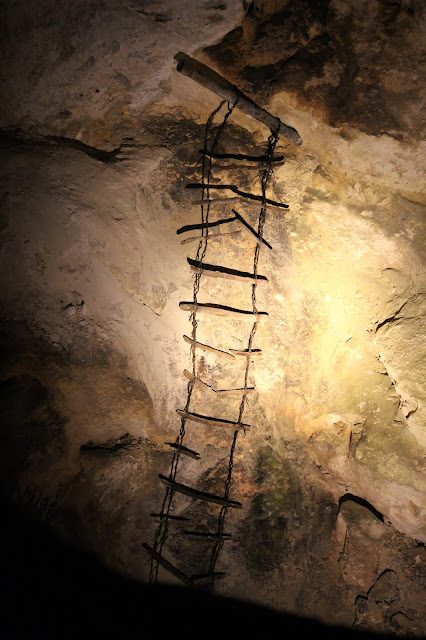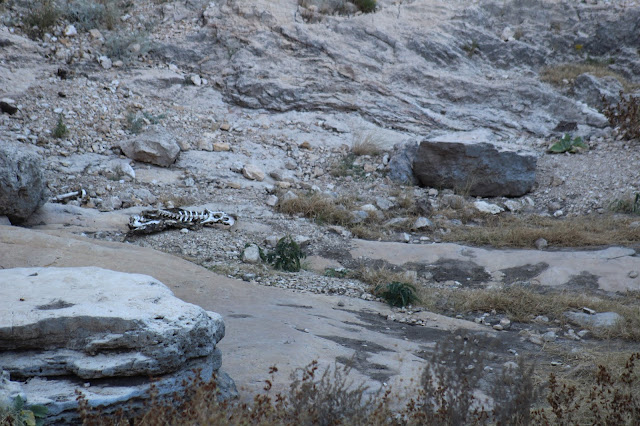I woke at 3:30 to a fairly clear 47º morning, and as I couldn’t get back to sleep, got up, ate breakfast, and got on the road by daybreak. As one drives through west Texas, there’s no doubt that Oil is the basis of the economy here.
I don’t know how much natural gas is burned off (wasted?) here, but almost every facility is sporting a perpetual flame.
I drove on into New Mexico, with an eye to visit part of America that I’d never seen before.Deep beneath the Chihuahuan Desert in southern New Mexico is a labyrinth of more than 300 limestone caves, carved over 250 million years ago, and since I was in the vicinity, it was time to visit the Carlsbad Caverns National Park.
At 9 a.m., I pulled into the Caverns, getting in “free” with my ”America the Beautiful - The National Parks and Federal Recreational Lands Senior Pass”, which costs $20 a year or $80 for a ‘lifetime’.
I watched the 15-minute introductory video, and then embarked on the self-guided tour, having rented the self-tour guide for $5. Although this Park gets around a half-million tourists visiting every year, there were few enough on this November morning to allow for a pleasant visit.
On the walk to the natural entrance, there were several interpretive signs for the visitors, and I always enjoy learning a little about the local natural history.
The Algerita (Mahonia trifoliolata) was used by the indigenous people for food (berries), medicine (a concoction used to treat sores), and a yellow dye was made from the roots.
Another sign noted the seeds of the Catclaw Acacia (A. greggii) were ground into a meal called pinole, and made into cakes or eaten as a mush. The native bees gather nectar when its yellow flowers bloom. I enjoy seeing the various species of acacia, as I remember “A Sprig of Acacia” that features in an old story known to those with eyes to see and ears to hear.
At the entrance to the cave, there’s a warning sign about Radon. Radon is a radioactive, colorless, odorless, tasteless noble gas that is reported to be carcinogenic. There seems to be quite an industry built up around testing homes for radon, costing about $75-200. For the same price, you can buy your own radon detector . . .
Thousands of Mexican freetail bats use the cave, and the interpretive signs happily let us know about them. This being November, most of the Caverns’ bats have decided to winter south into Mexico. The best time to see them might be in August or September, when daybreak or sunset flights are said to be pretty neat!
The entrance to the cave is paved and easy to traverse.
The old entrance was certainly more challenging, and there are remnants of the old ladders and staircases in the caverns. There are still wooden stairs that originally took people down a different way until the “iceberg rock” detached and fell crushing the stairs and necessitating a new entrance.
I presume that the Park Service leaves the old stairs, etc. in situ because they now have “historical significance”.
Carlsbad Cavern includes a large cave chamber, the Big Room, a natural limestone chamber which is almost 4,000 feet (1,220 m) long, 625 feet (190 m) wide, and 255 feet (78 m) high at the highest point. It is said to be the third largest chamber in North America and the seventh largest in the world. There are certainly lots of things to see here.
I did not find out what caused the green layer on this speleothem column. In some caves there are impurities of glauconite, an iron potassium phyllosilicate with a green colour. Or, because the Caverns are subtly lighted for the tourists, it could well be caused by algae growth on the calcite.
Whether you are a Cave Junkie, or never give karst caves a second thought, you can’t help but be amazed at the beauty of the formations.
Of course, people have given cute names to many of the dripstones and flowstones. This one’s the “Whale’s Mouth”, ostensibly because the folds in the rock look like baleen.
A block of solid gypsum is impressive for those of us who got decent grades in our Geology classes.
The water in the cave is crystal clear. I attempted a picture of some pools with neat little rimstone dams, but between my camera and my ‘droid phone being challenged by the low lighting, you’ll just have to visit here yourself to see those.
I did not take a flashlight, but used the light on my cell phone here and there to view some of the features; I think a really bright light would have detracted from the (my) experience. It is probably a good idea to take a light jacket, especially in the summer when the difference between the surface heat and the cool underground would be pretty great. The temperature of the Big Room of Carlsbad Cavern, at a depth of 750 feet (about 230 meters) below the surface, is 56°F (13°C).
Dropping off the audio guide, I left the Caverns and took the Desert Drive, seeing a few Scaled Quail. I tooled across the Guadalupe and Sacramento Mountains to Cloudcroft, checking into the Summit Inn among the pines and firs in the Lincoln Natl. Forest.
I suppered with a green chili cheeseburger and a couple pints at Dave’s Café. They seem to run a friendly, local place that made me feel at home. I’d eat here again.
Carlsbad Caverns Desert Drive eBird Checklist is Here































No comments:
Post a Comment